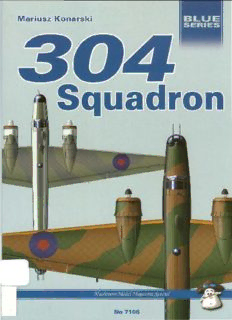
304 squadron : Wellingtons against the U-boats PDF
Preview 304 squadron : Wellingtons against the U-boats
Mariusz Konarski No 7106 Wellingtons against the g-Boats PublishedinPolandin200SbySTRATUS ArturJuszczak,Po.Box123,27-600Sandomierz1,Poland e-mail:[email protected] for MushroomModelPublications, 36VerRoad,Redbourn, AL37PE,UK. e-mail:[email protected] ©2005MushroomModelPublications. http://www.mmpbooks.biz Allrightsreserved.Apartfromanyfairdealingforthepurposeof privatestudy,research,criticismorreview,aspermittedunderthe Copyright,DesignandPatentsAct,1988,nopartofthispublication may bereproduced,storedina retrievalsystem,ortransmittedinany formorbyanymeans,electronic,electrical,chemical,mechanical, optical,photocopying,recordingorotherwise,withoutpriorwritten permission.Allenquiriesshouldbeaddressedtothepublisher. ISBN 83-89450-18-6 Editorinchief RogerWallsgrove EditorialTeam BartlomiejBelcarz RobertP~czkowski ArturJuszczak ColourDrawings JacekJackiewicz DTP DariuszKarnas, RobertP~czkowski Getinthepicture! Doyouhavephotographsofhistoricalaircraft,airfieldsinaction,ororiginalandunusualstories totell?MMPwouldliketohearfromyou!Wewelcomepreviouslyunpublishedmaterialthatwill helptomakeMMPbooksthebestoftheirkind.Wewillreturnoriginalphotostoyouandprovidefull creditforyourimages.Contactusbeforesendingusanyvaluablematerial:[email protected] Theauthorwouldliketothankthefollowingpersonsfortheirassistance: MariuszBorowiak,BettyClements,JerzyCynk,PrzemyslawChorqzykiewicz,BohdanEjbich, Adam Jarski, Andrzej Jeziorski, Marian Kowalczyk, Jacek Kutzner, PiotrLaskowski, Wojtek Matusiak, Andrzej Olejko, Robert Owen, MichalPeszke, KrzysztofRadwan, Andrzej Suchcitz, WojciechSankowskiandEdwardZarudzki. Printedby:DrnkarniaDiecezjalna, ul. Zeromskiego4,27-600Sandomierz tel. (15)832 31 92;fax (15)832 77 87 [email protected] PRINTEDINPOLAND Introduction 4 HistoryoftheSquadron 5 BomberCommand 5 CoastalCommand .•.........................................................................•..............•.................24 TransportCommand 67 Footnotes 73 Appendices 71 Colourprofiles 81 To My BelovedSon 304Squadron3 Introduction 304DYWiZjOn Bombowy"Ziemi Slqskiej" im. Ksi~cia J6zef Poniatowskiego,knownas304(Polish) SquadronintheRAF,wasfonnedon22 August 1940atRAFBramcote,Leicester.Itspersonnel wasrecruitedfrom amongairmenoftheformer2ndand6thAirRegimentsofthepre-warPolish AirForce,subsequentlyreinforcedwith3rdAirRegimentstaffarrivingafter thefall ofFrance. W/CdrJan Bialy was appointed OfficerCommanding, and SlLdrJulian Wajda his deputy. W/CdrWilliamM. Graham was the RAFadvisor. "Shootingtraining"on aTigerMoth. Engineoverhaulofan AvroAnson, oneofthetwo usedbytheSquadronin 1940-41. BattleTrainercodedNY-Z, oneofthetwosuchaircraft usedbytheSquadron. 4304Squadron History of the squadron 00 rnU0~ Q[bQ 83qJTI8JiliUill Bomber Command OneoftheWellington MklAs usedasatrainerin 1941. Initiallythesquadronwasequippedwith16FaireyBattleIlightsingle enginebombers and two BattleTrainers. From 1November 1940it used twin-engine Vickers WellingtonIAtrainers, andfrom 22November Ie 1940Vickers Wellington bombers. TheWellington crew includedthe pilot,co-pilot,navigator,radio-operatorandtwogunners. Mjrpil. JanBialy, thefirst "Atan early stage oforganisation- pplk pi!. Jan Bialy wrotein his commanderof304Squad memoirs thesquadronwasequippedwithFaireyBattles.Asingle-engine ron. I- aeroplanewithretractableundercarriage,crewofthree(pilot, navigatorand gunner), armedwithtwomachineguns, bombloadof750kg.Aircraftofthe typeweresimilartoourKaras,neverthelessthecrewshadtogetacquainted withthenewtypeofaeroplane,especiallypilotswhohadtoremembertoraise the undercarriageaftertake-offandloweritbeforelanding. (...)Crews hadto make overadozenflights to learn the newdevices, besidesthepilotsunderwentconversiontraining in 'blind'flying, piloting onlyaccordingtoinstrumentsinthecockpit.Navigatorsunderwentconver siontrainingaccordingtoEnglishairnavigationstandards,basedlargelyon maritimenavigation. Knowledgeofthistypeofnavigationwasnecessaryin daylightandnightflying, as wellasovervastoceanareas, whennavigator wasabletomakehiscalculationsbasedonlyaccordingtothewinddirection 304Squadron5 History of the squadron VickersWellingtonMkIe, andforce, speedoftheaeroplane, andflighttime. Gunnersoftheaeroplane codedNZ-T. weretrainedinoperatingthemachineguns, aswellas indropping bombs, alsonavigatorsweretrainedinthelatter. Thewholeconversiontrainingwasveryintensive.Aftersixweeks,bythe endofOctober1940, crewswere completedandtrained, andthesquadron waspreparedtoparticipate incombatoperations. InNovemberthesquadronwasre-equippedwithWellingtons.Bothflying andengineeringpersonnelneededconversiontrainingonthenewaeroplane Pplkpi!. PiotrDudzinski, type.Asflyingwasplannedtobedoneentirelyatnight, specialattentionwas thesquadron'scommander paidtoconversiontrainingofpilots,notonlyintermsoftwin-engineaircraft between20.12.1940and piloting, butalsoininstrumentflying. Navigatorswereadditionallytrained 12.11.1941. inlong rangenavigationwithoutaidofgroundfeatures. Shortage offlying personnelwasmadeupwithpostingsfrom Britishreserves(...)" DuetomisunderstandingswiththeBritishadvisor,on22December1940 W/CdrJ. Bialyleftthesquadron.Hewasreplacedattheheadoftheunitby W/CdrPiotrDudzinski. On27January 1941 Polish304and 305 Squadrons werevisitedbythe King George VIand QueenElizabeth. TheRoyal couple inspectedPolish airmenin adecoratedhangar. The visitwas agreathonour andjoyfor the personnel. Theunitachievedcombatreadiness on25 April 1941.Itwouldoperate undercontrolofBomberCommand. Its aircraft wereidentified bytheNZ codesappliedonthefuselages. 6304Squadron History of the squadron Establishmentofthesquadron,No.WARlBCI116(wartimeheavybomber squadronRAF) stipulatedthesquadronHQof 106and two flights of218, atotalof324officers and men. Itwas to beequippedwith 16twin-engine bombers.2 Atthetime304and305SquadronswerebasedatSyerston,Nottingham shire.On25April 1941 twocrews(ofPIOAntoniSymandFlOKazimierz Czetowicz)of304Squadron tookpartinaraid onRotterdam. Thecrewof WellingtonICNZ-D(N2852)includedPIOJerzyIszkowskiastheco-pilot, andhewroteinhismemoirs:3 "Imademyfirstcombatsortieon25April1941intheunfamiliarcrewof FlOCzetowicz.Aeroplane-Wellington-Pegasusno.2852.Bombs:incendiary andhighexplosive.Task:bombpetroltanksinRotterdam, Holland. Thiswas thefirstoperationalattemptofthesquadron.Twocrewsweremadeupofthe Kpt.pi/.KazimierzCzetow bestpilots. Take-offwasatdusk. Inthedarknessofthenightwepassedthe icz, thesquadron'scom Englishcoastand, aftercrossingtheNorthSea, wecrossedtheDutchcoast manderbetween16.08.1942 southofEmden. Approaching the bombingarea wemaintainedaltitudeof and18.01.1943. 12,000to14,000feet.1ntheEmdenareawecircledinsearchoftheprescribed targetofdestruction. Thecompletelydarknightmadeitimpossibletoidentify thetarget,relativelysmallanddifficulttohit.Wedroppedthefirstmagnesium bomb. Forafewminutesthegroundwaswellvisible. Iadjustedtheheading slightlyandthe tanksappearedahead. Imadeaquickpass, butsuddenlya coneofaboutadozen coupledsearchlightscaughtusinthe middleofthe beam. Powerfullights blindedus andfilled the blackabyss. By aviolent manoeuvre Ifreed myselffrom the trap and resumedthe attack, this time withgoodeffect.Asalvoofbombsleftthefuselage. Quicklydepartingfrom Rotterdamwewatchedtheresultsofthebombardment.Sixpoweifulflashes ofhighexplosivebombexplosionsandhundredsofsmallerincendiarysparks startedfourfiresofwhichtwoexpandedrapidly.Later, itcouldbeseenhow bombsfrom otheraircraftoftheraidhitthosefires. WellingtonMkIC, NZ-F; notethelettersizeandcam ouflagescheme. 304Squadron7 History of the squadron WellingtonMkIeduring preparationforanopera tionalflight. 500poundbombloading. The inscriptionis "Foryou criminal" Another500poundsbomb withthe inscription "Shiverbandits" 8304Squadron History 01 the squadron As soon as we turnedourbackon Emden, three searchlightconescaughtusandtheartilleryfire inten sified. Things onlycalmeddown belowusonce wegot overthesea". The subsequent action, on the night of2 May, involvedfourcrews.Theyattackedtheportandcityof Emden. Theduty wascarriedoutwithoutlosses. Next sortieswereflownonthenightof5May,withLeHavre asthetarget.Thistimethefirstpainfullossesweresuf fered. During the attack the Wellington (R1443) with thecrewofPIOAntoniSymwasshotdown. Thecrew ofPIO Jerzy Iszkowski was incredibly fortunate. As the engines were started, the aeroplane burstinflames. Fire immediately engulfed the entire port wing, wrote Iszkowski in his memoirs, which had several thousandlitresofpetrolinitstorsionboxes.Fromthere itcaughtthefuselage,loadedwithexplosivesinthebomb bays. Extremelydangerous situation. British auxiliary maintenancepersonnel ran away from the dangerous place. Only three Polish groundcrewmen and myself ofthecrewstayedneartheaeroplane.BeforeImanagedtounstrapanddrop Loadingammunitionforthe myparachutewithitsharnessandruntotheaeroplane,thethreefittershave noseturretmachineguns, alreadybroken into theaeroplane withfire extinguishers. Thecrewpassed WellingtonMkIe. fireextinguishersfromnearbypoststoreplacethosealreadyempty. BritishfIrefIghtingtruckapproachedtheburningaeroplanerapidly,butit stoppedseveralhundredyardsaway.Quiterightso,asitcouldblowupwith Extinguishingthefire on its entirecrewoffiremen. Moments later, when thefire was extinguished, aWellingtonMkIe. 304Squadron9
